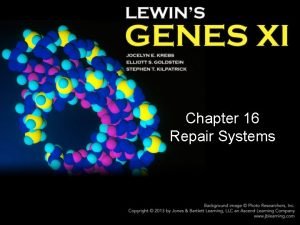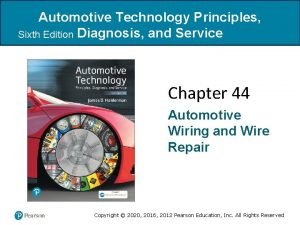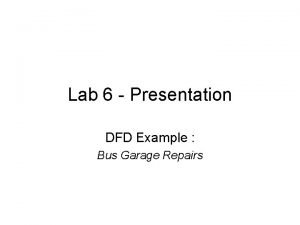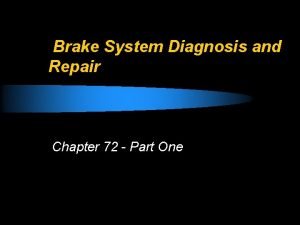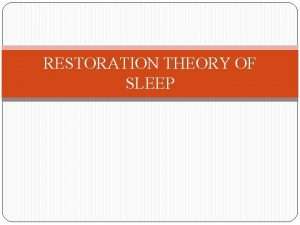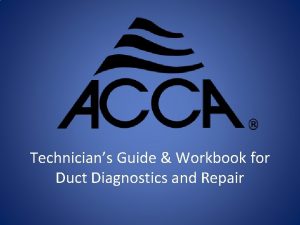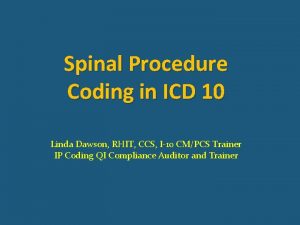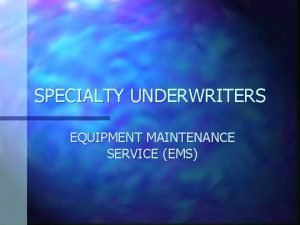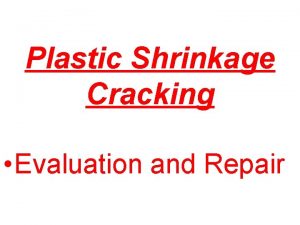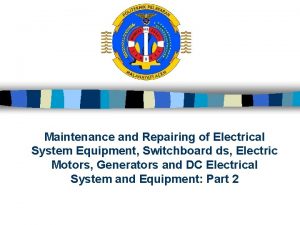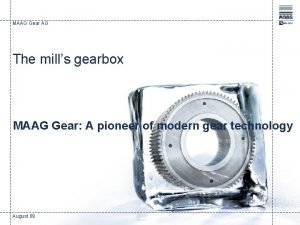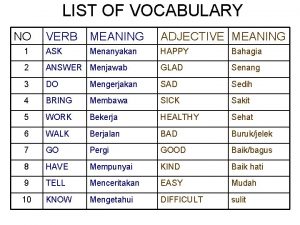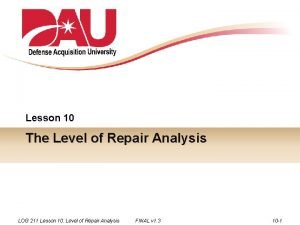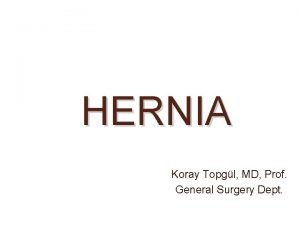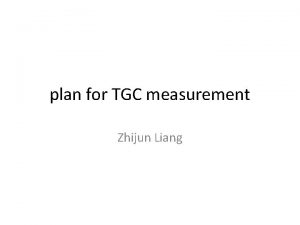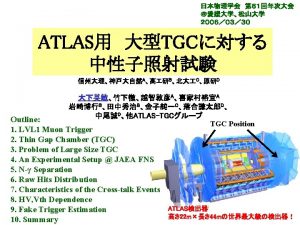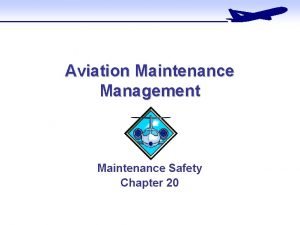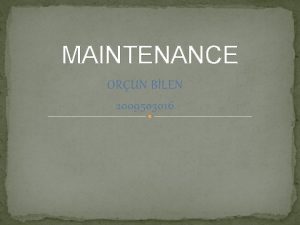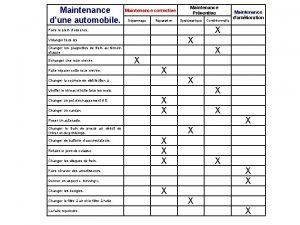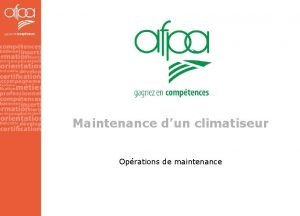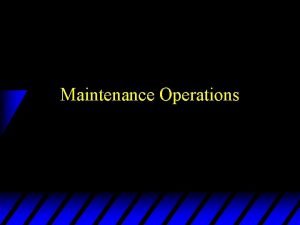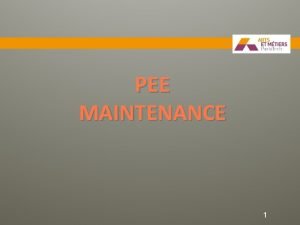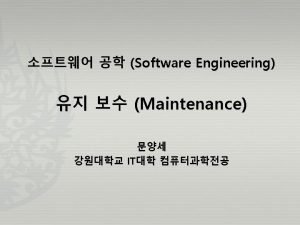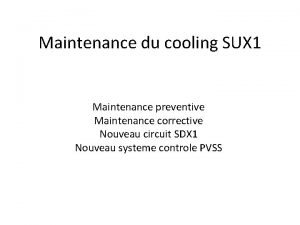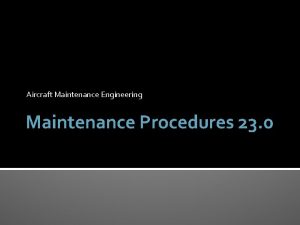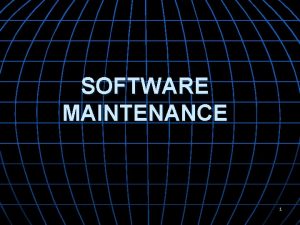Development of s TGC Repair and maintenance of



























- Slides: 27

Development of s. TGC • Repair and maintenance of BW • Short introduction to the Physics needs. • Development of s. TGC’s, how to achieve the needed precision. • Short history of test beams • Construction of large prototype (Module -1) • Results of FERMILAB test beam • Remaining problems • Conclusions

Repair and maintenance of BW • New problematic chambers appeared when moving to old n-pentane gas containers that have special sealing that add impurities to the gas. • Problem is also observed in detector gain increase during the same periods. • The situation would be far worst if there would be people without the necessary experience to treat the problematic detectors.

Long project to produce the spare detectors although the situation was known end of 2012, some of the needed detectors were not produced; major work in BB 5 to refurbish old ones • • 27 of the 32 bad detectors will be exchanged until the end of November. Major testing operation during the last year in BB 5, mainly done by Vladimir and Physicists from Chile. All needed detectors for the replacements have now (as of last week) been tested and qualified. Replacement will re-start (8 have already been replaced until July 2014).

Some of the replacements will be difficult • In many cases 2 -3 detectors have to be removed, to allow for the installation of the relevant one. • For some of the detectors, gas distribution lines will have to be modified. • It is important to have all the testing elements (gas and HV) working to test immediately the detectors after installation. • Time is very critical, due to the closure of ATLAS at the end of the year. • • • LHC run 2 will start with 99. 8% working detectors. If someone does not take the responsibility and gets the know-how accumulated since 1989 for repairing the detectors during the run, one will soon have >100 not working detectors. We all know who will be blamed for the problems.

Physics motivations • Various physics motivations for the upgrade program of LHC. • Shut-down during 2017 -2018 will allow to exploit the LHC with L=1 -2 X 10³⁴ and collect 300 fb⁻¹. This will allow: • – Following the Higgs discovery, one would like to perform a precise measurement of its couplings: • Measured its coupling and prove that it is a Higgs using a single channel WH, to measure H->bb, ττ, μμ, WW independently of QCD corrections=> this requires an efficient trigger on W->μν for μ with P(T)>25 Ge. V/c. With the s. LHC, one would expect to collect 3000 fb¯¹, which would allow to test: – Following the Higgs discovery, then HH production could be observed (for example ~400 HH->4τ, 1800 HH->2τ W(W->jets)W(->lν))=>This requires an efficient lepton trigger with P(T)>25 Ge. V. – One needs to efficiently trigger on VV final states to corroborate that the Higgs mechanism is the only component that normalizes the WW scattering cross section =>this requires an efficient trigger on W->μν for μ with P(T)>25 Ge. V/c.

Most of the µ triggers come from the End-Cap Ttrigger rate as function of η • • • High μ trigger in End-Caps due to backgrounds. Including innermost layer will improve rates by 100. Need high resolution (<1 mrad) Source of background

Layout of the system • • • To reduce μ trigger rate in forward direction, need accurate vector (>1 mrad) in front of magnet. Groups from Canada, Chile, China and Israel developed the s. TGC that have achieved good position (~70μm) resolution and high efficiency in high background environment Two type of detectors to be used in ATLAS Phase I New Small Wheel (NSW) upgrade (s. TGC & Micro. Megas). New method to produce large (2 X 1. 2 m²) multilayer PCB’s had to be developed that can be placed with respect t each other with a precision of 40μm. First final size quadruplet of such a detector has been tested at FERMILAB (T 1049 in M 6 -FTBF between 9/5 to 20/5).

Precision requirement needed for reconstruction • • Although the requirement are that the position of the measurement coordinate should be known to a precision of 30μm R. M. S. (to be used for off-line reconstruction), an effort has been made to design detectors where such a precision can be achieved between the different layers of a quadruplet at the construction step, to be used for on-line trigger, where such precision is not needed. The 80μm R. M. S. precision on the positioning of the measuring planes is much harder to achieve and it is based on precise machined frames, to be able to achieve it.

Motivation for the design and its implementation • • • s. TGC’s work in a quasi-saturated mode, and therefore changes in the anode-cathode distance of 100μm produce changes in gain of ~20%. The position resolution is determined by the accurate strip positions, while its local measurement (charge sharing between strips could vary) might not be uniform, this is a small effect. The driving elements in the present s. TGC design are: – Make very precise strip boards that can be referenced precisely from outside. – Use the outside surfaces of the cathode planes as your reference, since small variation of the cathode to anode distance will not have an important effect in the performance. – Use the same composite material (FR 4) everywhere to avoid mechanical tensions due to temperature changes (it is not only the operational temperature that matters, but also transportation and storage)

Motivations for the design and its implementation • • • Modern CNC machines have micron resolution in their mechanical movements (can be used with a small ball sensor to accurately measure mechanical pieces). All strip boards are machined together with their brass inserts (these are needed, since FR 4 edges cannot be used as references, since they deteriorate after first use). Also precision holes are drilled to insert with force, stainless-steel balls for later use with x-rays. All operations are performed by gluing, which requires uniform pressure on the gluing surface, this does not allow the use of precise pins, since they require some tolerance to allow for the pressure parallel to the pins. On the thickness, all spacers and support pieces are machined with 20μm tolerances, including wire supports. Cathode surfaces can have deviations of up to 50μm from planarity, therefore , a filling material (NOMEX honeycomb) is used that is 100μm thinner that their surrounding supports, to allow the glue to fill the space.

Motivations for the design and its implementation

Aging tests (I) • • Many aging tests have been performed since 1997 at different flow rates, showing no deterioration of performance with rates (up to 1. 3 C/cm (Fukui et al, NIM A 419 (1998), 497502. This was followed in 2007 by a long irradiation up to 6 C/cm showing the same lack of effect. The n-pentane, being a good cleaning agent helps in keeping clean wires, while the quasi saturation of the operation, makes it insensitive to small wire deposits.

Aging tests (II) • • • By going to a low resistivity cathode (100 KOhm/square), one can increase the rate capabilities to <30 KHz/cm 2. Both elements have been implemented in 10 small prototypes that have been tested during the last year. Most important, they need to be able to take the high radiation levels of SLHC. A small chamber has accumulated 6 Coulomb/cm, without any deterioration= 20 years at SLHC with safety factor 5. Anode and cathodes were analyzed for deposits in Chile, where a new Lab was established to continue radiation tests. Deposits due mainly to Carbon and Oxygen

Testing • Although one is trying to improve on an existing technology, a lot is based on tests performed in the past for ATLAS-LHC, in particular for neutrons, extensive tests were performed by our Japanese colleagues: – H. Nanjo et al. , Nucl. Instr. and Meth. A 543 (2005), p. 441. – H. Oshida et al. , Nucl. Instr. And Meth. A 587 (2008), p 259. • • Long term irradiations using photons have been performed (6 Coulomb/cm) together with the Chilean colleagues. A long series of test have been performed: – In Summer 2007 at T 9 to evaluate position resolution. – In December 2008 with 14 Me. V neutrons (Soreq Nuclear Center) to gain confidence in the operation with high neutron flux. – In February 2009 with a Co(60) source giving 30 KHz/cm 2 on a large area detector. – In June 2009 at H 8, to obtain position resolution in a large area detector. – In July 2009, again with a Co(60) source to get efficiencies at high rate. – In September 2009 a neutron test was performed at Demokritos with 5. 56. 5 Me. V neutrons. – In November 2010, combined test with small tubes MDT in H 8. – Combined test in August 2011 with small tubes MDT (MPI) in H 8. – High radiation tests at the SOREQ nuclear Center (November 2011) – Combined test in H 8 (May, October 2012) – Qualification of Module -1 at FNAL in May 2014

Single plane efficiency measured at Demokritos efficiency Vs. rate 100 D D 3 5 90 efficiency[%] 80 70 60 Be a m 50 40 30 20 10 11 m m DD 46 DD 78 45 O 0 35 45 55 65 75 Detected rate [Hz/cm^2] 85 • At 2 x. LHC neutron rate, single plane eff. : 99%, while at 3 x. LHC reduced to 96%. • NOT A SINGLE SPARK during the full irradiation. D D 9 1 0

Single layer efficiency is good enough • • • If your start time is within 25 ns, single γ background is not a serious problem (~6%) but δ rays (in time) is more of a problem. Photon efficiency is different for different detectors (TGC is more like CSC’s=> expect ½ of the rate. Most of the high Energy neutron sensitivity comes from the cathodes. Due to the quasi-saturated operation of the TGC, the response is 3 -5 times lower than the ionization deposits. Single layer inefficiency in the presence of ATLAS-like neutrons <6%.

Construction of Module -1 • Following the construction of single detector planes, they were assembled using a precision jig on a granite table. • The jig is pressed against the brass inserts of the detector and attached to the granite table. The contact with the pins is checked by ensuring electrical contact between the inserts and the pins with an Ohmmeter.

Quadruplet assembly • • Following the quadruplet assembly, the relative position of the individual planes was checked using a microscope. All this was performed during the Passover holidays. It was found that there were large (up to 150μm deviations) between different planes. The large deviations were found to be due to a separate machining of the strips and the inserts. This problem was partly solved in the next series, however bad quality machining was found in the inserts. There is a close contact with the firm performing the machining, to ensure that no such an event will occur in the future. The thickness of the cathode boards were well within the specifications, however this was not the case for the wire frames, all of them having deviations at the same place. The thickness of the quadruplet was within the tolerances (80μm RMS, measured in 19 points, with maximal single point deviations of 250μm).

Test Beam of Module-1 at FNAL • At arrival, only 2 people to put it together

With many people that appear for the photo • Sandwich the s. TGC quadruplet prototype between 2 pixel telescopes (EUDET)

And many people that worked hard (without much sleep for 2. 5 weeks)

Outside pixel telescope allows to obtain an independent measurement of the resolution • But one has to get rid of multiple scattering • Cut on χ² of fit to a straight line.

Correct for charge dependence of position due to cross talk between strips • Beautifully reproducible in all layers, and between all strip planes.

Get the best position resolution achieved on a large gas detector • Combined result on all 4 planes and at various positions during the scan.

Next test beam preparation at CERN • Nice collaboration between Chile, Canada and Israel. • Soon to get a few engineers and students from Russia.

Remaining problems • Get good machining of inserts. • Get good uniformity of cathode boards. • Write the specs for the Market Survey and qualify the firms. • Have a real detector Physicist that takes responsibilities and not only talks about responsibilities.

Conclusions • The BW TGC’s will start LHC Run-2 in very good conditions, thanks to the effort of many people. If no physicist with knowledge of detectors takes soon the responsibility of the day-to-day running, it will become a disaster area. • The s. TGC development for the ATLAS upgrade has been very successful. One has achieved the best position resolution of any large area gas detector as measured independently with a pixel telescope. If no physicist with knowledge of detectors takes soon the responsibility of making it into a construction project within the specifications, there is a danger of not being ready for the ATLAS upgrade. • The success of the Israeli Experimental HEP has been to concentrate all the efforts into one project, in a close collaboration. By diversifying, our impact will be like the impact of a banana republic.
 Tgc trastorno
Tgc trastorno Base excision repair vs mismatch repair
Base excision repair vs mismatch repair Mismatch repair
Mismatch repair Automotive maintenance and light repair answer key
Automotive maintenance and light repair answer key Whats primase
Whats primase Chapter 81 brake system technology answers
Chapter 81 brake system technology answers Electronic suspension system
Electronic suspension system Chapter 42 gasoline injection diagnosis and repair
Chapter 42 gasoline injection diagnosis and repair Chapter 44 automotive wiring and wire repair
Chapter 44 automotive wiring and wire repair Bus garage repair dfd
Bus garage repair dfd 337 form faa
337 form faa Brake pedal reserve distance
Brake pedal reserve distance Repair and restoration theory of sleep
Repair and restoration theory of sleep Repair renovation and restoration of water bodies
Repair renovation and restoration of water bodies Repair and restoration theory of sleep
Repair and restoration theory of sleep Maintenance of records and reports in obg
Maintenance of records and reports in obg Tru count air clutch rebuild kit
Tru count air clutch rebuild kit Duct diagnostics
Duct diagnostics Icd 10 pcs code for discectomy
Icd 10 pcs code for discectomy Ems equipment repair
Ems equipment repair Types of position
Types of position Control center centurylink
Control center centurylink Aci 503
Aci 503 Switchboard maintenance
Switchboard maintenance Maag gearbox repair
Maag gearbox repair Verb 3 destroy
Verb 3 destroy Lora level of repair analysis
Lora level of repair analysis Spermatic cord contents mnemonic
Spermatic cord contents mnemonic


